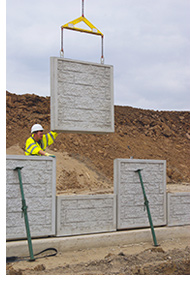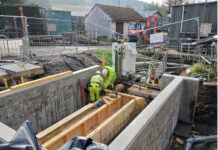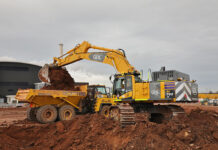What is thought to be the first Island of Ireland installation of a particular type of concrete panel-faced, reinforced soil retaining wall system is currently under construction on the new A8 Belfast to Larne highway improvement project.

A network of reinforced-soil retaining walls which will form part of the upgrading of the strategic A8 route in Northern Ireland is under construction by Perth-based civil and geotechnical specialists, Maccaferri Construction.
The A8 is one of the five Key Transport Corridors identified in the Regional Development Strategy and the Regional Transportation Strategy for Northern Ireland.
The Department for Regional Development is undertaking improvement works that will involve the realignment and upgrading to Dual 2 Lane All Purpose carriageway of the A8 between Coleman’s Corner and Ballyrickard Road, at a construction cost of £105 million. The new route includes the by-pass of the villages of Bruslee and Ballynure. This upgrade of about 14.5km of the A8 between Belfast and Larne as a partially on-line/partially off-line dual carriageway, with associated hard strips, will incorporate a number of grade separated junctions and the provision of a central median safety barrier.
Maccaferri Construction is building a network of 16 reinforced-soil retaining walls which form abutments and wing walls to eight new structures which are being constructed.
The design and construction of the A8 project is being undertaken by JV Contractors Lagan/Ferrovial/Costain (LFC).
LFC were particularly keen to work with Maccaferri as the company provides a fully indemnified, combined design and construct package – a service that is not readily available for reinforced soil, concrete panel structures in Ireland or in the UK.
The walls are being constructed using Maccaferri’s own MacRes system of large, concrete facing panels, installed in conjunction with high strength PARAWEB geosynthetic reinforcement, manufactured by Linear Composites, also a Maccaferri subsidiary.

The MacRes/PARAWEB reinforced soil structure is a system extensively used outside the UK with over 500,000sqm of walls completed worldwide. On the UK mainland, the system was recently used in the upgrading of the A13, Sadlers Farm interchange near Basildon, Essex. However, its use in the construction of the A8 Belfast to Larne Dualling scheme is thought to be a first for Ireland.
PARAWEB is BBA Roads and Bridges Certified geosynthetic strapping for use with panel faced reinforced soil systems. The PARAWEB elements are placed in the ground between successive layers of compacted fill and connected to concrete facing panels. The strength of the PARAWEB reinforcement is adjusted to suit the design loads. This makes the system simple to construct as the standard concrete panels all have the same number of connection points. This optimises the efficiency of the structure and allows the construction of very tall walls capable of withstanding high loads.
According to Maccaferri Project Manager Craig Stoker, there are clear benefits in the use of polymer reinforcement over traditional steel strapping. “Rather than increasing or reducing the spacing to change the reinforcement strength as you would do with steel, different strengths of polymer strapping can be incorporated to increase the capacity.”
The concrete facing panels are factory cast in steel moulds. The unpigmented panels are steel reinforced and have integral lifting eyes and strapping connection loops cast into each unit. Installation commenced with the preparation of a 175mm-thick, 450mm-wide concrete levelling pad along the line of the panel wall. The first row of panels was placed in position in a castellated pattern. Proprietary props were then used as temporary supports and the panels were clamped together to further ensure stability.
Strapping is looped through special attaching points cast into the reverse face of each panel at 750mm centres, typically four to each panel. Strapping is installed as a continuous loop laid into the backfill and temporarily held in position with steel pins.
A drainage layer 300mm deep is placed behind the panel as backfilling progresses. Backfill is granular SFHW 6I/6J imported material which is fully compacted in accordance with the specification for highway works. Subsequent courses of panels are placed in position using a lifting device attached to the boom of a tracked excavator and lift inserts cast into the tops of the panels. The top of the walls will be capped using specially made precast coping units with in-situ concrete backing.










